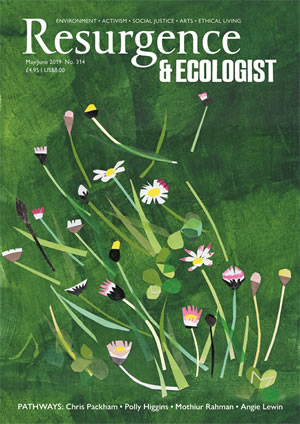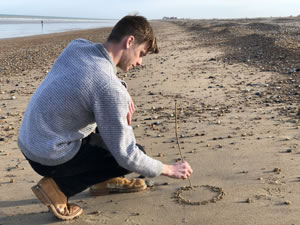The surf is roaring at Bantham in south Devon as William Thomson begins his tide walk. Looking across towards Burgh Island, he explains how sandbanks and the merging river Avon contribute to a complex system of rips and currents. As a Royal Geographic Society fellow, map designer and author of The Book of Tides and The World of Tides, Thomson is perfectly placed to read this scene and describe in simple terms how this coastline’s geography interacts with the elements. He crouches down to draw a diagram in the sand, outlining the shore as he explains that incoming waves only break where the water is half as deep as the wave is tall – so bigger waves break further from the shore.
This summer, Thomson is travelling around the British coast in his electric campervan to host tidal walks as part of his new Tide School. As a young, inquisitive surfer, he realised that if he understood his environment and the way tides work, he could read the waves more accurately and surf without taking unnecessary risks. “People might choose to go into the sea where the waves aren’t breaking, but that’s where the water is deepest and the rip is the strongest – even an Olympic swimmer can’t outswim a rip: you have to swim out perpendicular to it.”
While crewing for the lifeboat near his home in Kent, Thomson was shocked by how many incidents were caused by people’s total lack of knowledge of tide dynamics: “I want to empower people to read the clouds or judge the waves so they can really enjoy exploring their natural surroundings and head off on exciting adventures, safely and with a better knowledge of the elements,” he says, as he takes a long blue rope out of his dry bag. He holds one end, I hold the other. As he flicks the rope, it wiggles up and down in peaks and troughs: “This is how waves work – it’s the energy that’s moving along the rope, not the rope itself. So in open ocean the swells are moving up and down as energy is transferred, and it’s only in shallow water that the water starts moving with the wave.”
Thomson goes on to explain that tides work in exactly the same way. “It takes six hours for high tide to move along the Channel from Land’s End to Dover – three big waves of tides travel around Britain. It takes 12 hours for the high tide to go full circle, and the time that the peak passes one point is directly related to the moon phase. So on a full moon I know it’s high tide at Wick and Aberdeen at midnight, and at Dover at midday.”
Local tides are all part of a much bigger system: “It’s quite inspiring to think about how everything is interconnected and how tide waves have no border – they defy geopolitics. Globally, tides move like waves in amphidromic systems influenced by the gravitational pull from the moon and the Earth’s tilt.” Using a set of coloured golf balls – white for the moon, blue for the Earth and yellow for the sun – Thomson demonstrates how the moon phases impact daily tides. When all three bodies are aligned on a full or new moon, the combined gravitational pull gives bigger ‘spring tides’, resulting in faster currents, higher high tides and lower low tides.
Walking along onto the Ham, overlooking the bed of the Avon, Thomson goes on to explain ocean currents: “To understand currents on a local scale, you need to understand wind,” he says as he draws another diagram in the sand. “During the daytime, the land heats up, air rises and moves onshore. But land heats and cools more quickly than water, so the ocean retains the heat and breezes reverse to offshore at night. Exactly the same concept happens at planet level, which is why we get hurricanes near the Equator.”
Thomson’s skill is in making the science visual, practical and relevant – it’s an eye-opening framework for discussing climate change, too. As he heads off in his campervan to the next tide walk location, he journeys between the projects harnessing energy from the tides and waves with a strong belief that Britain could one day be 100% renewable-powered.








